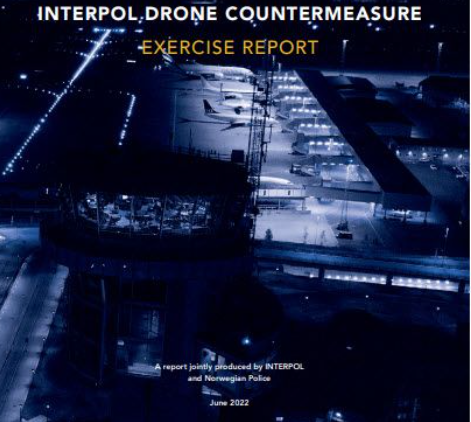INTERPOL has published the results from the INTERPOL Drone Countermeasure Exercise that was held in September 2021 at Oslo Gardermoen Airport. This gathered various CUAS systems that were tested and assessed, highlighted in a report by Unmanned Airspace last week.
The report can be accessed here.
For 2022, INTERPOL Innovation Centres’s ambitions concerning drones and associated emerging technology are as follows:
- Involvement in the European Union Project Courageous and testing of drone countermeasures based on the scenarios developed as part of the programme.
- Publication of an updated INTERPOL Global drone framework in close cooperation with our partners such as, ENLETS.
- INTERPOL IC will continue to build upon the findings of the Drone Expert Group and continue to assist the 195 INTERPOL member countries.
Publication of the document coincided with INTERPOL’s fourth expert conference on the use of drones held in the Norwegian capital of Olso from 20-22 June 2022. Over 300 participants from more than 50 countries converged in the Norwegian capital, representing a multitude of law enforcement agencies as well as attendees with security and emergency preparedness functions.
Hosted alongside the Norwegian police and UAS Norway, the conference allowed law enforcement and industry partners to share expertise and best practices on both the security risk that drones can represent and how this fast-moving technology can assist law enforcement in their essential mission.
INTERPOL is always looking for innovative solutions, and how these can be used by police in member countries,” said Madan Oberoi, INTERPOL’s Executive Director of Technology and Innovation, opening the conference.
This year’s Drone Expert Summit, held in Oslo, Norway, brought together a large number of subject matter experts. The outcomes of last year’s drone incursion exercise, conducted in collaboration with Norwegian authorities, were widely appreciated by the participants,” Mr Oberoi added. He also announced INTERPOL’s intention to prepare a strategic framework to help member countries in realizing the potential of drones for law enforcement, as well as managing the threats posed by criminal actors using drones.
Incursions every day
Authorities worldwide are reporting the presence of illegal drones near or inside airports and other critical infrastructure on a daily basis. Given the potential threat and disastrous repercussions an unauthorized drone could have, law enforcement agencies have increasingly been tasked with confronting the novel threat of drones and policing access to lower airspaces.
Counter-drone systems, or C-UAS systems, have been identified as a potential solution to address the challenges of unmanned aircraft systems. C-UAS systems can detect, track, identify and mitigate a drone threat entering the monitored airspace.
Nevertheless, drone countermeasures are a relatively new technology that uses different forms of automated systems to maintain airspace safety. Despite increased attention toward the potential benefits of C-UAS systems, the capabilities of these systems are still difficult to benchmark. Consequently, end-users find it challenging to match the right counter-drone tools to the specific use cases.
Threat, tool and evidence
INTERPOL’s work analyzing and evaluating drone technology for law enforcement use is structured around three key components:
- Threat: The use of systems and intelligence to counteract the threat from drones
- Tool: The use of drones by law enforcement and associated guidance
- Evidence: The recovery of data and identifiers from drones and associated equipment
In September 2021, INTERPOL carried out a full-scale drone countermeasure exercise to evaluate and test drone countermeasures in a secure airspace environment. At this week’s conference in Oslo, INTERPOL presented findings from that exercise.
Among the conclusions, experts noted that in many cases drone technology appears to be an asymmetric threat for law enforcement agencies, which can struggle to obtain the resources and expertise that drone countermeasures systems necessitate.
A multi-stakeholder approach is also crucial, where each actor understands their role and responsibility during the C-UAS test and when a real drone incursion occurs.
Based in Singapore, INTERPOL’s Innovation Centre aims to research, develop and implement the latest tools and approaches to fight international crime, bringing together academics, analysts, law enforcement officers and specialists in technology.
For more information contact:




